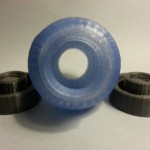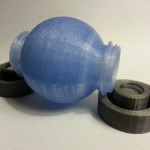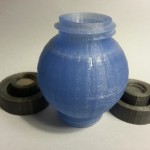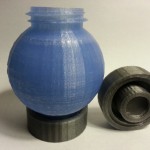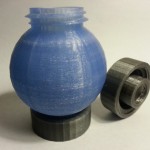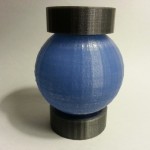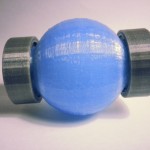Parameters
Globe: x = 65 mm, y = 65 mm, z = 78 mm
Caps: x = 46 mm, y = 46 mm, z = 15 mm
Overall Height: 86 mm
Material Use: 50 grams (Globe) + [17 grams (Caps) X 2] = 84 grams
Print Time: 210 mins (Globe) + [75 mins (Caps) X 2] = 360 mins = 6 hours
My original question: Can a 3D printed object be responsive to its environment and to the dynamic energies of the people and processes that interact with it?
My double sided snow globe is a spherical globe with two ends fitted with threaded caps designed to hold magnets inside the inverted basins. The original intent was to fill the globe with water along with ferrofluid, a fluid that becomes magnetized in the presence of a magnetic field. The theory was that the ferrofluid would become magnetized by the magnets placed inside the basins of the caps, making visible the magnetic field.
The current form of my idea is not yet represented in 3D. What started out as a simple sphere to demonstrate a simple magnetic field may turn into a slightly more complicated object to demonstrate the magnetic field created by an electromagnet. In its current state the ferrofluid simply becomes magnetized to the magnets, which does not demonstrate the responsiveness I desire.
Although, I was able to easily manipulate my objects in the digital modeling environment to fit the progression of my idea, its only influence was to execute the idea as it progressed through my trial and error testing of the actual fluids and magnets that will eventually inhabit the globe. Currently, the globe itself has escaped any iterations; the caps have been redesigned a few times already. However, the ease with which I am able to quickly manipulate the design makes the actual testing of the fluids and magnets less intimidating. I have become more willing to alter my design knowing the ease with which it can be done, without getting discouraged with the multiple iterations through which it has gone.
The only technical constraints of the 3D printing process that affected the progress of my idea were the limitations of the actual printing of the globe and caps. Although, 3D printing makes easier the prototyping process, the limited availability of the printers, the troubleshooting of the various filaments, as well as the printer and software, made the printing process less accessible than the modeling environment. In addition, when the globe and caps were finally printed, it took some manual convincing to make my amateur thread design meet my high expectations.
As it currently sits on my desk, my double sided snow globe could be used as a container for various purposes (with the exception of holding an actual liquid). However, whether accomplished inside the next week or not, I intend to complete my investigation of electromagnetic fields and whether I will be able to create a 3D printed object to make visible the invisible. My intention is to continue to experiment with making an electromagnetic field until either a) I do or, b) my frustration leads me to finally take a class to learn about the incredibly complicated physics and mathematics involved in creating exactly the field I want. Regardless of the outcome, I’m feeling accomplished at what I’ve learned thus far and excited to learn more.
